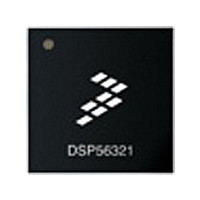DSP56303VL100 Freescale Semiconductor, DSP56303VL100 Datasheet - Page 9

DSP56303VL100
Manufacturer Part Number
DSP56303VL100
Description
IC DSP 24BIT 100MHZ 196-MAPBGA
Manufacturer
Freescale Semiconductor
Series
DSP563xxr
Type
Fixed Pointr
Datasheet
1.DSP56303AG100.pdf
(108 pages)
Specifications of DSP56303VL100
Interface
Host Interface, SSI, SCI
Clock Rate
100MHz
Non-volatile Memory
ROM (576 B)
On-chip Ram
24kB
Voltage - I/o
3.30V
Voltage - Core
3.30V
Operating Temperature
-40°C ~ 100°C
Mounting Type
Surface Mount
Package / Case
196-MAPBGA
Device Core Size
24b
Format
Fixed Point
Clock Freq (max)
100MHz
Mips
100
Device Input Clock Speed
100MHz
Ram Size
24KB
Program Memory Size
Not RequiredKB
Operating Supply Voltage (typ)
3.3V
Operating Supply Voltage (min)
3V
Operating Supply Voltage (max)
3.6V
Operating Temp Range
-40C to 100C
Operating Temperature Classification
Industrial
Mounting
Surface Mount
Pin Count
196
Package Type
MA-BGA
Package
196MA-BGA
Maximum Speed
100 MHz
Device Million Instructions Per Second
100 MIPS
Lead Free Status / RoHS Status
Lead free / RoHS Compliant
Available stocks
Company
Part Number
Manufacturer
Quantity
Price
Company:
Part Number:
DSP56303VL100
Manufacturer:
FUJI
Quantity:
1 000
Company:
Part Number:
DSP56303VL100
Manufacturer:
FREESCALE
Quantity:
672
Company:
Part Number:
DSP56303VL100
Manufacturer:
Freescale Semiconductor
Quantity:
10 000
Company:
Part Number:
DSP56303VL100B1
Manufacturer:
Freescale Semiconductor
Quantity:
10 000
1.5.2
1.5.3
Freescale Semiconductor
D[0–23]
AA[0–3]
RAS[0–3]
RD
WR
TA
BR
Signal
Name
Signal
Name
Input/ Output
Output
Output
Output
Output
Input
Output
External Data Bus
External Bus Control
Type
Type
Tri-stated
Tri-stated
Tri-stated
Ignored Input
Reset: Output
(deasserted)
State during Stop/Wait
depends on BRH bit
setting:
• BRH = 0: Output,
deasserted
• BRH = 1: Maintains last
state (that is, if asserted,
remains asserted)
State During Reset,
Stop, or Wait
Ignored Input
During
Reset
State
Table 1-8.
Table 1-7.
Last state:
Input : Ignored
Output :
Tri-stated
During Stop
DSP56303 Technical Data, Rev. 11
or Wait
State
Address Attribute—When defined as AA, these signals can be used as chip selects or
additional address lines. The default use defines a priority scheme under which only
one AA signal can be asserted at a time. Setting the AA priority disable (APD) bit (Bit
14) of the Operating Mode Register, the priority mechanism is disabled and the lines
can be used together as four external lines that can be decoded externally into 16 chip
select signals.
Row Address Strobe—When defined as RAS, these signals can be used as RAS for
DRAM interface. These signals are tri-statable outputs with programmable polarity.
Read Enable—When the DSP is the bus master, RD is an active-low output that is
asserted to read external memory on the data bus (D[0–23]). Otherwise, RD is tri-
stated.
Write Enable—When the DSP is the bus master, WR is an active-low output that is
asserted to write external memory on the data bus (D[0–23]). Otherwise, the signals
are tri-stated.
Transfer Acknowledge—If the DSP56303 is the bus master and there is no external
bus activity, or the DSP56303 is not the bus master, the TA input is ignored. The TA
input is a data transfer acknowledge (DTACK) function that can extend an external bus
cycle indefinitely. Any number of wait states (1, 2. . .infinity) can be added to the wait
states inserted by the bus control register (BCR) by keeping TA deasserted. In typical
operation, TA is deasserted at the start of a bus cycle, is asserted to enable completion
of the bus cycle, and is deasserted before the next bus cycle. The current bus cycle
completes one clock period after TA is asserted synchronous to CLKOUT. The number
of wait states is determined by the TA input or by the BCR, whichever is longer. The
BCR can be used to set the minimum number of wait states in external bus cycles.
To use the TA functionality, the BCR must be programmed to at least one wait state. A
zero wait state access cannot be extended by TA deassertion; otherwise, improper
operation may result. TA can operate synchronously or asynchronously depending on
the setting of the TAS bit in the Operating Mode Register. TA functionality cannot be
used during DRAM type accesses; otherwise improper operation may result.
Bus Request—Asserted when the DSP requests bus mastership. BR is deasserted
when the DSP no longer needs the bus. BR may be asserted or deasserted
independently of whether the DSP56303 is a bus master or a bus slave. Bus “parking”
allows BR to be deasserted even though the DSP56303 is the bus master. (See the
description of bus “parking” in the BB signal description.) The bus request hold (BRH)
bit in the BCR allows BR to be asserted under software control even though the DSP
does not need the bus. BR is typically sent to an external bus arbitrator that controls the
priority, parking, and tenure of each master on the same external bus. BR is affected
only by DSP requests for the external bus, never for the internal bus. During hardware
reset, BR is deasserted and the arbitration is reset to the bus slave state.
External Bus Control Signals
External Data Bus Signals
Data Bus—When the DSP is the bus master, D[0–23] are active-high,
bidirectional input/outputs that provide the bidirectional data bus for external
program and data memory accesses. Otherwise, D[0–23] are tri-stated.
Signal Description
External Memory Expansion Port (Port A)
Signal Description
1-5












